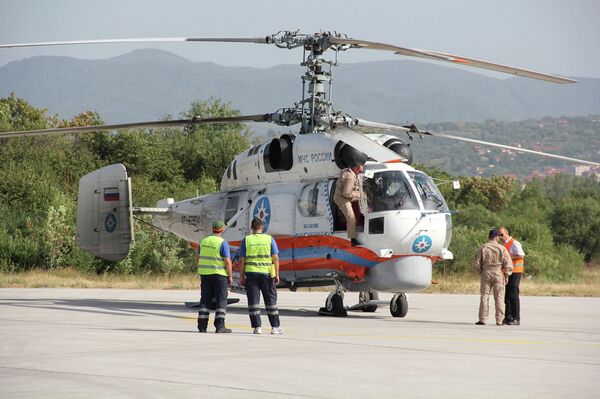Russian firefighting aircraft have been deployed to southern Europe to help fight increasingly damaging blazes triggered by a spell of very hot weather in the region, the Emergency Ministry said on Sunday.
"In Serbia alone, there are at least 200 wildfires blazing and the situation is complicated by the high air temperatures and dry forests," said Emergency Ministry foreign activity spokesman Yury Brazhnikov.
"Currently, firefighting aircraft are in great demand in Europe, and aviation is working with great intensity," Brazhnikov said.
"We have deployed a Kamov Ka-32 firefighter helicopter at Serbia's Nis airbase," Brazhnikov said. Since the beginning of August it has carried out 58 drops of around 300 tons of water in total to help extinguish fires, together with ground-based Serbian firefighters, he said.
"The helicopter will son be re-based at Sarajevo and used to fight fires in Bosna and Herzegovina," he said.
Russia also sent a Beriev Be-200 amphibian firefighter to Nis on Saturday to join in the firefighting effort across Serbia, Bosnia and Greece, he said.
Russia also plans to send its largest firefighting aircraft, the Ilyushin Il-76 transport, to Serbia on Sunday afternoon, he said.
"This aircraft will be used to fight fires in more complex spots in hilly areas, where there are explosives stored and where it could be difficult to send in fire-engines," he said.
"We are also considering sending in an Mi-26," he said. The Mi-26 is the world's largest helicopter and can also carry underslung buckets for firefighting.
The Russian Emergency Ministry is coordinating its work with European Union agencies, Brazhnikov said, adding Albania was also considering whether to use Russian aviation assets.
"Greece is also in the field of our attention, and the Russian-Serbian humanitarian center is ready to give help to Greece and send aviation and ground rescue units," he said.
Russian-Serbian fire-engines have already been deployed in the hills near Athens recently to help save an Orthodox monastery which was threatened by fire, he said. The crews, together with Greek and Bulgarian rescue teams, managed to beat the fires and save the building, he said.
The success of Russian aviation in firefighting has not gone unnoticed abroad. In May, a Be-200 carried out trials for the U.S. Interagency Air Tanker Board, which promotes safety of airtanker operations in the U.S., at Taganrog, south Russia, and made practice water-drop demonstration flights for United States Forest Service officials, Beriev said.
The Taganrog trials were conducted jointly by International Emergency Services, an American company which wants to buy the Be-200 and operate it in America, and Beriev, which funded the trials.
The Be-200 can land on water and scoop up 3,000 gallons (12,00 liters) of water into its hull, and can then fly quickly to an affected area and drop its load onto a fire.
The United States has an urgent need to renew its air tanker fleet as many existing planes in the role are obsolete and coming to the end of their lives. The FAA, the country’s aviation watchdog, recently ordered safety checks on Lockheed Neptune P2V air tankers operated by Neptune Aviation after large cracks were found on a wing spar in one aircraft.




